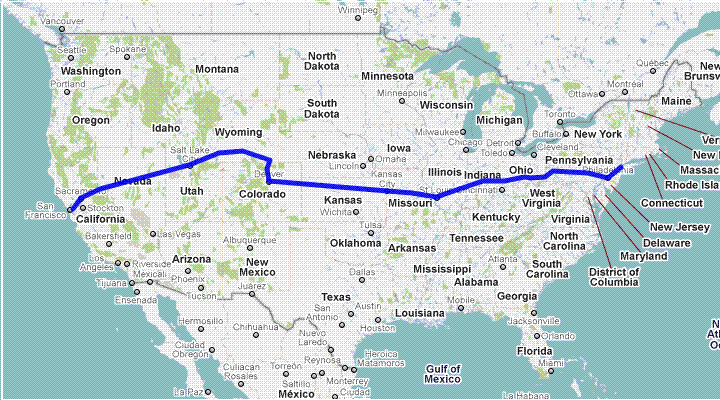 It often seems there is a deep canyon lying between what we can do and what needs to be done as a community, as a local region, as a state, as a national region, or as a nation.
It often seems there is a deep canyon lying between what we can do and what needs to be done as a community, as a local region, as a state, as a national region, or as a nation.But the Steel Interstate is a national program that a coalition of determined groups of advocates scattered across the country could get going. It bridges regional interest conflicts, and offers a way to advance some of the interests of:
- Interstate motorists, by taking a substantial amount of semi truck traffic off the road, reducing both driving stress and road damage
- Advocates of car independence, by providing a Rapid Rail network that can extend the reach of Regional HSR train services in a financially sustainable way
- Private sector organized labor, by providing an ongoing project that will employ people in constructing the system and producing materials for the system, and as a direct consequence reduce the import share of national spending, increasing the employment impact of all newly financed spending, private or public
- The large "army of unemployed" benefit in precisely the same way
- Advocates of a development of an ecologically sustainable, by saving 90% of the energy cost of long haul freight transport by diesel powered semi-truck
- Advocates of effective climate change mitigation strategy, in precisely the same way
- Progressive Patriots, by advancing the cause of Energy Independence and weakening the foundation of the protection racket that oil companies use to gain control over US military power in support of corporate interests and in opposition to US national interest
Of course, I want to talk process, but it seems to be network maps that catches people's interest. So how I will go about this is alternating Map and Process.
Stage 1 Map: The National Line
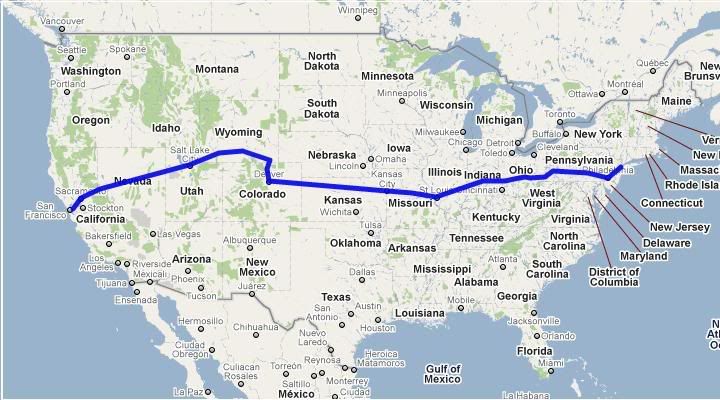 The genesis of Stage 1, from which the balance of the map follows, was a comment in the dkos edition of the Sunday Train, Sunday Train: Attacks on HSR in Flyover Country, by IndianaDemocrat
The genesis of Stage 1, from which the balance of the map follows, was a comment in the dkos edition of the Sunday Train, Sunday Train: Attacks on HSR in Flyover Country, by IndianaDemocratSo, Ya' Wanna Build A High-Speed Line?
Then build one that will actually have an IMMEDIATE TANGIBLE ECONOMIC BENEFIT.
Reconstruct the National Line form Pittsburgh to St. Louis as a High-Speed, three-rail line.
This bypasses Chicago, reduces cross-country travel times by as much as a day-and-a-half, OR MORE, depending on Chicago delays. Make it a Nationally-owned and operated line, available to all railroads to use. Even the Shortlines, for a fee.
Put that money to use actually doing something that could help breath life back in to manufacturing, instead of a flashy boondoggle.
The Stimulus Flyover projects in Chicago are a start, but little more than band-aids that don't really address the bottleneck problem.
by IndianaDemocrat on Sun Feb 21, 2010 at 08:00:59 PM EST
That's what Line#1 does. Now, as explained later in the process section, each stage is around 3,000 miles, so there's more to it: New York to Pittsburgh is the STRACNET alignment that is generally the route of the Amtrak Pennsylvanian, St. Louis to Denver is a STRACNET freight corridor, and Denver to Oakland, California is generally along the route of the Amtrak California Zephyr.
Before you react to the passenger service appeal of the corridor .... stop. Take a deep breath. This is at its core a plan that is to provide an opportunity for Sustainable Energy Independent long distance freight transport. Consider the truck traffic on Interstate 70 between Pittsburgh and Denver before rejecting the alignment out of hand.
What makes IndianaDemocrat's proposal so powerful is that STRACNET through Ohio and Indiana is a bit of a tangled mess, and it is quite plausible that the loss of the National Line is the reason.
Also, bear in mind that freight trains can change locomotives. Swapping locomotives costs time ... but if the run on an electric corridor is fast enough, both in terms of speed and in terms of capacity to handle traffic without delay, it can easily cover the time-cost for long-distance traffic.
So this is not an isolated corridor, its a trunk corridor that can be accessed by a wide number of the STRACNET corridors.
Stage 1 Process: Foundation Concepts for the Steel Interstate Project
After four to six months writing Sunday Train's, its easy for me to lose track of the fact that while there are some regulars, there are also always some people who are dropping by for the first time. So if the following is old news to the regulars, my apologies.
The Brawny Recovery. Back when the US was Energy Independent, progressive macroeconomist's would patiently explain that there is simply no problem with the government running a deficit during an economic downturn.
After all, "Money" is just a permission slip from the government: its resources that can limit the government's freedom to deficit spend. And during a downturn we have idle resources.
"Except" ... except that now we are no longer Energy Independent. Instead, we are addicted to imported energy. Like any Dependent Economy, there is always a risk that boosting demand for domestic resources will lead to problems in the exchange rate of the local money, causing a crisis in access to the external resource.
So under the situation of growing addiction to Energy Imports that has been pursued as active government policy over the past three decades by both Republican and Democratic administrations ... we can't ignore the impact on our external balance.
So we need to do more than just do "Keynesian Pump Priming": we need to ensure that we spending some of that money on stuff that helps us make stuff. That's the "Brawny Recovery": economic stimulus that also develops our national economic strength.
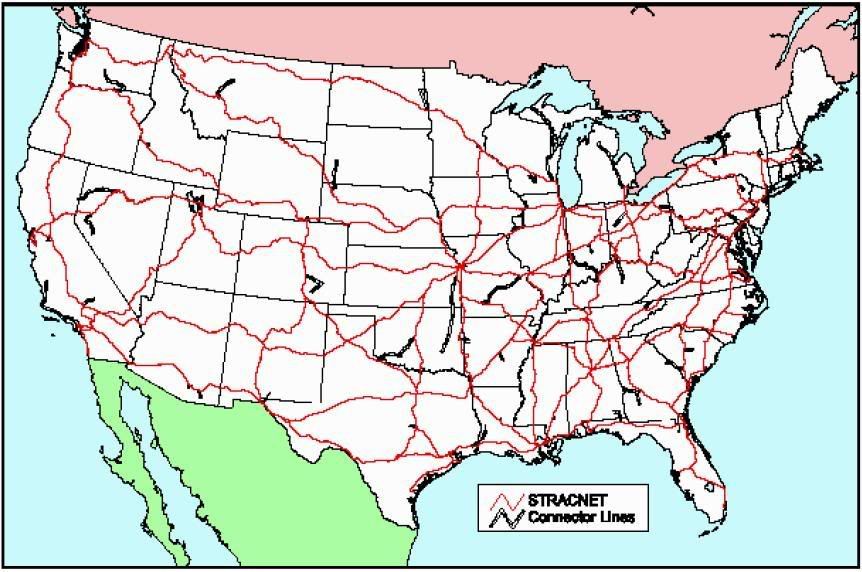 Ecological and Economic Sustainability. I do not spend a lot of time in the Sunday Train arguing about whether the US Economy is in an unsustainable ecological overshoot, nor about accelerating climate chaos, nor about a wide range of ecological and social failings of our current transport system. But Energy Efficiency ties into these concerns as well. Economic Growth is getting more stuff done that people want done. The massive material wastes built into our present system, means that we have an opportunity to mine what is presently wasted to get economic growth without requiring more material support.
Ecological and Economic Sustainability. I do not spend a lot of time in the Sunday Train arguing about whether the US Economy is in an unsustainable ecological overshoot, nor about accelerating climate chaos, nor about a wide range of ecological and social failings of our current transport system. But Energy Efficiency ties into these concerns as well. Economic Growth is getting more stuff done that people want done. The massive material wastes built into our present system, means that we have an opportunity to mine what is presently wasted to get economic growth without requiring more material support.And this is what makes it possible economically to get these projects launched. We are doing a lot of things in ways that only made economic sense with $1 a gallon gasoline or diesel (in 2010 prices). The economic foundation has fallen away, but the institutional supports keep obsolete systems and practices alive like so many zombie transport systems.
Opportunity for Sustainability. It is easy to fall into a status quo bias in which we evaluate every change in terms of what the impact will be under our present way of doing everything else. But I don't believe we can actually keep doing everything else the same way either, so I also look at how easy it is to upgrade something to full sustainability.
For long distance transport, there is no mature transport technology that has a stronger opportunity for sustainability than electric rail. Given the massive energy waste of long haul truck freight, the correct speed is "fast enough to capture freight shipments that would otherwise go on the road." Hence the focus on 100mph Rapid Electric Rail freight, which is fast enough to do precisely that.
STRACNET. STRACNET is the department of defense Strategic Rail Corridor Network. Forty years ago, the Pentagon noticed that rail lines that it depended upon in its planning for logistical support in times of crisis were in the process of being ripped out. So rail corridors with strategic impact were identified, and the STRACNET process was born, whereby the Department of Defense looks at proposals to abandon a rail line that is on STRACNET and tries to hammer out a solution that maintains the logistical capacity it requires.
As in so many other things in our society, we are only "allowed" to do serious national planning if there is a defense component. But we have been wearing massive (and politically motivated) blinkers over the past thirty years: the addiction of our nation's economy to massive oil imports is one of the greatest threats to national security that we face.
The presumption is that these investments will take place on STRACNET corridors - but note that there is some flexibility in this, since regional development banks would be in a position to negotiate with Department of Defense logistics bureaucrats to add or shift STRACNET status from one corridor to another.
Stage 2 Map: The Gulf and Southwestern Line
 The next line to roll out ... and under the system proposed below, each line begin rolling out the year after the previous one ... runs from Miami to Los Angeles via Jacksonville, Pensacola, Mobile, New Orleans, Baton Rouge, Houston, San Antonio, El Paso, Tuscon, and Phoenix.
The next line to roll out ... and under the system proposed below, each line begin rolling out the year after the previous one ... runs from Miami to Los Angeles via Jacksonville, Pensacola, Mobile, New Orleans, Baton Rouge, Houston, San Antonio, El Paso, Tuscon, and Phoenix.One thing this line focuses on is port traffic, which is why it starts at Miami, runs to Los Angeles, and runs through Mobile, New Orleans, and Houston (with junctions to Galveston).
This is the Florida Atlantic Coast route and then the old Amtrak Sunset Limited, before it was chopped back to NOLA/LA.
You'll probably notice that there is no "whistling past Dixie" here ... more like "whistling through Dixie".
Stage 2 Process: Institutional Foundations
So, if we want to tap the energy efficiency of long distance rail, how would we go about doing it?
First, we learn the lessons of Amtrak in the Northeast Corridor and set the "Line Builder" authority up as a form of public regional development bank from the outset. We charter it with a specific responsibility to get a Rapid Electric Rail corridor established, and specify the cities that it must serve when construction is finished.
How to fund the thing? (Note: I am being "cute" here, using "fund" in its 1930's classical technical sense, and will discuss "finance" in another stage.) If we want an integrated, national network, it has to be publicly owned infrastructure. If we want the network integrated with the existing rail system, it has to be primarily on freight railroad right of way.
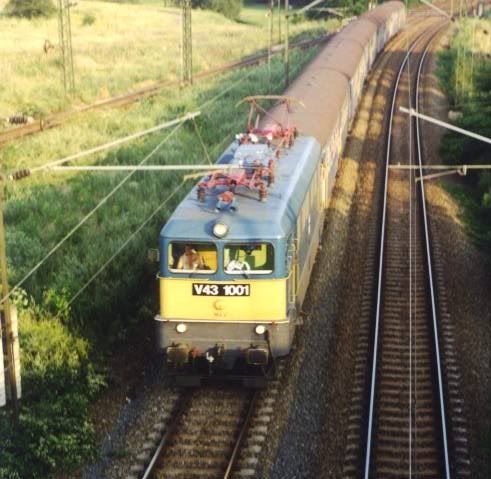 Once a rail path in a rail corridor has been electrified, it is very capital efficient to electrify all tracks in that corridor. So the basis of the regional steel interstate development bank making itself welcome is to provide the infrastructure for all existing track in the corridor, as desired by the right of way owner, in return for cooperation in providing for a Rapid Electric Rail freight path in the corridor.
Once a rail path in a rail corridor has been electrified, it is very capital efficient to electrify all tracks in that corridor. So the basis of the regional steel interstate development bank making itself welcome is to provide the infrastructure for all existing track in the corridor, as desired by the right of way owner, in return for cooperation in providing for a Rapid Electric Rail freight path in the corridor.And then the original capital cost project is funded by charging access fees to the tracks owned by the public authority, and user fees for the electricity consumed by all electric trains, on either the Rapid Rail or Heavy Rail paths.
Indeed, since having the capacity is in the national interest, while its using the capacity that is in the interest of the private railways, its possible to ensure that the terms are attractive by mandating that the user and access fees will be set at the level that provides for full recovery of the original capital cost in four years of 100% capacity utilization.
So the more heavily railroads use the stuff (and therefore the more useful it is to them), the faster the infrastructure is paid back. If capacity utilization is 20%, it will take 20 years to refund the cost ... if capacity utilization is 50%, it will take eight years to refund the cost.
Obviously, during an extended oil price shock, it will be used even more intensively, but there is nothing in this proposal that is waiting for things to change in terms of gas and diesel prices. This thing would have been used at the diesel prices at their trough right after the Panic of 2008 hit in full force..
Indeed, the question that is up in the air is how intensively it will get used and how rapidly rapid electric freight traffic will gain market share. Alan Drake, who developed the most ambitious form of the Steel Interstate system, was able to get modelling of the system done by the Millenium Institution, and this will get used under current economic conditions.
The funding system proposed here and financing system proposed below will allow the infrastructure to be built. If it turns out that we experience another oil price shock, the result will be to accelerate the roll-out of the corridors. However, the proposed institutions are entirely workable under present economic conditions.
Stage 3 Map: The Gulf and Northwestern Line
 Its a distinctive fact of the shape of our country that the Great Lakes and Gulf of Mexico makes the country narrower north to south east of the Mississippi, and wider north to south west of the Mississippi. Stage 3 takes advantage of that to provide for the first crosslinking while bringing in the northwestern quadrant that is under-served by the first two corridor.
Its a distinctive fact of the shape of our country that the Great Lakes and Gulf of Mexico makes the country narrower north to south east of the Mississippi, and wider north to south west of the Mississippi. Stage 3 takes advantage of that to provide for the first crosslinking while bringing in the northwestern quadrant that is under-served by the first two corridor.Stage 3 starts at Mobile, linking to the Gulf and Southwestern Line, and runs up through Birmingham, Nashville, Louisville, and up the STRACNET connector to the STRACNET corridor to Chicago, It crosses the National Line with a high capacity cross-over junction at Terre Haute, Indiana. From Chicago, it runs through Milwaukee, Madison, Minneapolis, and then along the northern STRACNET corridor through North Dakota, Montana, Idaho, and Washington to Seattle.
In Amtrak terms, the Northwestern portion of this corridor is the Empire Builder route.
Stage 3 Process: Financing the System
Looking ahead to a system of repaying the original capital cost over time means that a system is needed for paying the interest expense of the capital spending between the time that the money is spent and the time that the capital cost is paid back. This is what is classically called "Financing" the capital expense.
My proposal cuts to the heart of the matter. The problem with gas taxes is that they are seen as making gas more expensive.
But the US is not Addicted to Energy Imports because we have lost the ability to produce oil. We are the third biggest oil producer in the world, behind Saudi Arabia and Russia but well ahead of Iran, Mexico, China, Canada, UAE, Venezuela, Kuwait, Nigeria, and etc. With roughly 5% of the World's population we produce about 10% of the world's oil.
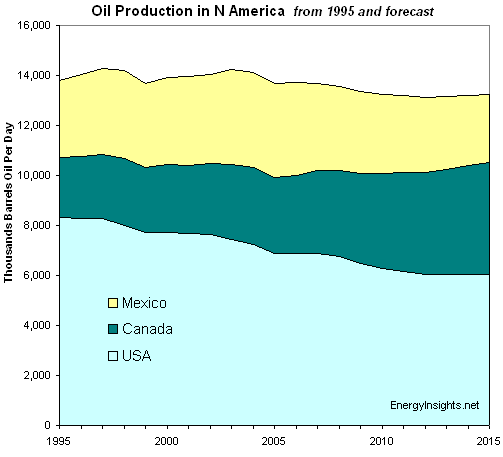 We are not an "oil poor" country. We are an oil wasting country, consuming about one fourth of the world's supply, 2.5 times our production and 5 times our "global per capita share".
We are not an "oil poor" country. We are an oil wasting country, consuming about one fourth of the world's supply, 2.5 times our production and 5 times our "global per capita share".That's why "drill baby drill" was such a load of total bullshit. We already "Drill, Baby Drill" ... the myth that we do not is a convenient lie, and no basis for national policy.
And as the biggest oil waster of the world, our chief power to keep oil prices from skyrocketing is by cutting our massive waste of oil.
So this proposal goes to the heart of the problem. For each rail line, a $0.01 per gallon tariff is imposed on all imports of petroleum and petroleum products. The tariff starts at $0.01, and the regional development bank for the first line can start work, then $0.02 and the second bank can start work, up to $0.05.
A massive step toward independence from the Saudi Oil Sheiks and the Phantom Iranian Menace and the corruption and savagery of Nigeria's national oil policy and Hugo Chavez ... whoever you do not like among the nations we rely on to feed our insanely counter-productive imported oil addiction, a massive step toward reducing the imports "from them".
It may well be that the original interest subsidy will not cover the whole capital cost ... but that's OK, since building the first 2,000 miles will start generated user and access fee revenues which can be recycled into new capital spending until the line is finished. And then, when the construction of the mandated line is finished, the development bank uses the tariff revenue to accelerate repayment of the original capital cost.
And then, when the full capital cost is repaid, the tariff is extinguished.
We import in the neighborhood of 200b gallons of petroleum and petroleum products a year, so a $0.01 tariff yields in the neighborhood of $2b annually. That supports from $40b to $50b in bonds at interest rates of 4% to 5% ... less at higher rates, more at lower. Alan Drake's original proposal was costed at around $450b for over 30,000 miles of track ... so I am taking about $45b for 3,000 miles of track and working on that basis.
That is why these first three lines have all been in the neighborhood of
And building the system to its robust ... that is what allows "in the neighborhood" to work out. A robust funding framework with the flexibility to cope with moderate oil prices and extremely high oil prices is what we need to insure our economy against the potentially rocky road that lies ahead.
This is, after all, an infant industry tariff - a finance rather than protective infant industry tariff to be sure - so once the system is launched, the tariff should go away.
At that point, the longer term mandate of the regional development bank to promote the development of energy independent and carbon neutral transport in systems within its broader catchment kicks in.
Stage 4 Map: The Front Range Line, the Great Lakes Line, and the Southeastern Line
Apologies that the Southeastern Line was inadvertently omitted from the map ... you can see if on the final map below
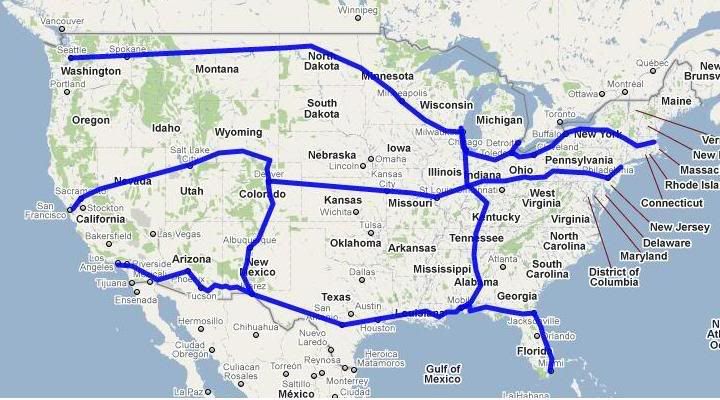 So far New England extending into the heavily trafficked I-80 and I-76 corridors has not received a line, and there are obviously still large holes in the network. So at Stage Four there are three shorter Lines.
So far New England extending into the heavily trafficked I-80 and I-76 corridors has not received a line, and there are obviously still large holes in the network. So at Stage Four there are three shorter Lines.The Great Lakes Line starts in Boston and runs through Springfield MA, Albany and Buffalo, NY, Erie PA, Cleveland and Toledo OH, northern Indiana, into Chicago. The Southeastern Line extends from New York through DC, Richmond VA, Raleigh and Charlotte in NC, and Atlanta GA to connect with the Gulf and Northwestern at Birmingham, AL. And the Front Range Line runs from El Paso through Albuquerque through Colorado Springs to Denver.
The first three corridors are launched in three years, one after the other, each with a dedicated $0.01 in petroleum tariff revenues. These are three shorter lines, so the revenue is split: 0.4 cents goes to the Great Lakes Line, 0.4 cents goes to the Southeastern Line, and 0.2 cents goes to the Front Range Line.
Stage 4 Process: Building the Coalition to Get there
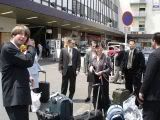 So far, this is just blueprinting. But without an opportunity to get involved, then a blueprint just gathers dust on the shelf. What is needed is to convert the blueprint into an Action Plan.
So far, this is just blueprinting. But without an opportunity to get involved, then a blueprint just gathers dust on the shelf. What is needed is to convert the blueprint into an Action Plan.This requires coalition building. Steel Interstate Advocates need to form local advocacy groups, in all the cities and states served by the corridors ... which is all of them except Hawaii and Alaska. Even states that do not have a corridor have:
- access to the corridor via their local rail network
- benefits of the corridor in reducing national oil consumption
- and participation in the energy independence transport investment by the "Line" development banks once they have finished rolling out the corridors.
But long experience is that face to face meetings are required to actually look people in the eye and talk to them in person and get things moving.
Of course, the groups can be freestanding, but do not have to be freestanding. It can be an interest group working party in a union local. It can be an interest group working party in a local political party. It can be an interest group working party as part of Drinking Liberally. It can be an interest group working party wherever you can pluck up the courage to suggest it.
This is one reason why I've focused on sketching a robust system ... a fine tuned, well oiled machine would be fine for a fine tuned, well oiled political machine to put into action as a demonstration of its prowess. But this is something that we are going to have to make into an issue, over the next year, or three years, or decade if that is what it takes.
Stage 5 Map: The Midwestern Line, the Texarkana Line, and the West Coast Line
 Stage Five finishes up the main trunk network ... using STRACENET corridors to provide North/South trunks in the Midwest and West Coast. The Midwest Line runs from San Antonia to Austin, crosses the Texarkana in Dallas/Fort Worth, Oklahoma City, Wichita to Kansas City, then on the STRACNET corridor through Des Moines to Minneapolis. The Texarkana runs from through Dallas/Fort Worth to Little Rock Arkansas, Memphis TN, and connects to the Gulf Coast and Northwestern at Nashville. And the West Coast line runs from San Diego to cross the Gulf and Southwestern east of the LA Basin, up the Central Valley to Sacramento, where it crosses the National Line, then Northern California through Redding, up the STRACNET alignment to Eugene Oregon, and then up to Portland to connect to the Gulf and Northwestern at Seattle.
Stage Five finishes up the main trunk network ... using STRACENET corridors to provide North/South trunks in the Midwest and West Coast. The Midwest Line runs from San Antonia to Austin, crosses the Texarkana in Dallas/Fort Worth, Oklahoma City, Wichita to Kansas City, then on the STRACNET corridor through Des Moines to Minneapolis. The Texarkana runs from through Dallas/Fort Worth to Little Rock Arkansas, Memphis TN, and connects to the Gulf Coast and Northwestern at Nashville. And the West Coast line runs from San Diego to cross the Gulf and Southwestern east of the LA Basin, up the Central Valley to Sacramento, where it crosses the National Line, then Northern California through Redding, up the STRACNET alignment to Eugene Oregon, and then up to Portland to connect to the Gulf and Northwestern at Seattle.The Midwestern Line receives 0.4 cents from the fifth tranche of imported oil tariff, the West Coast line 0.4 cents, and the Texarkana receives 0.2 cents.
Stage 5 Process: What Do You Think?
Well, this is a big fat whopping Sunday Train, and will post an hour late to boot ... but what do you think? In order of importance:
- What do you think is an effective means of organizing to promote a national Steel Interstate system?
- What do you think about the Line Development Bank system?
- What else do you think about the mechanics of the proposal?
I expect to get lots of suggestions of different alignments and roll-out sequences ... and I am happy to discuss my why's and wherefore's on each and every line proposed as well as the logic of the sequencing ... but you know, even if not one single line I propose is adopted, and it is rolled out in reverse order ... any serious real world steel interstate system beats the best possible fictitious real world steel interstate system.
So if the lines that people are willing to fight for end up being completely different to the maps I draw up this weekend ... people willing to fight for any steel interstate line is such great news that I'd be sitting pretty.
The Headliners: Midnight Oil - The Power and the Passion
supported by Bethany and Rufus


4 comments:
I love this idea. Of course, I am in Colorado where the government attitude seems to be to support car drivers, no matter the cost. I will send this proposal around though.
(It might be technically easier to go through Wyoming, though. The slopes of the passes are not as steep.)
Bán đang muốn làn da của mình trắng hồng tự nhiên , chúng tôi giới thiệu cho bạn những cách làm trắng da toàn thân tự nhiên , công thức kem trộn trắng da toàn thân, tiêm trắng da có an toàn không, cách mọc tóc nhanh cho nam, cách bôi kem chống nắng đúng cách, uống gì mát gan đẹp da . Những chữa cận thị không cần phẫu thuật vừa nhanh và an toàn .
Kênh thông tin mua bán nhà đất tại Việt Nam , nếu bạn muốn mua hay bán nhà đất thì chỉ cần vào đây , chúng tôi sẽ cho mọi người biết về tin của bạn, nhà đất hcm, nhà đất gò vấp, nhà đất thủ đức, nhà đất tân phú, nha dat quan 9 . Còn chần chờ gì nữa , hãy đăng tin mua bán nhà đất nhanh nhanh .
Thanks for sharing.
Nếu cần gửi hàng đi huế thì a/c liên hệ bên mình nhé.
Hotline: 0903751981
Post a Comment